
Official Edgar Rice Burroughs Tribute and Weekly Webzine Site
Since 1996 ~ Over 10,000 Webpages in Archive
Volume 1272
Part of the

Library Project
The ERB / Jack London Connection II
by Bill Hillman


THE MUCKERS
Shortly after the magazine publication of London's two novels, The Abysmal Brute and The Valley of the Moon, both about prize-fighters who turn their backs on violence in favor of a more refined lifestyle, ERB started writing the first half of The Mucker. The Mucker follows this theme and also brings in other London elements such as the hero being shanghaied into service on a ship (The Sea-Wolf), and being cast ashore with the aristocratic daughter of a millionaire. The ensuing character development of Billy Byrne, the Mucker, parallels Wolf Larsen of The Sea-Wolf in many ways.
Another fascinating London connection appears in the second half of The Mucker which pays tribute to contemporary writer and poet, H. H. Knibbs, whom ERB admired. This half of the book is subtitled, "Out There Somewhere," and it draws inspiration from Knibbs poem of the same name. ERB introduces a n a poet-spouting hobo, who peppers the text with quotes from Knibbs, Robert Service, and others. Curiously the hobo gives his name as L. Bridge (London Bridge?) and some ERB scholars have gone so far as to suggest that the character is a thinly disguised Jack London on one of his numerous trips through the hobo jungles of America.One more connection involves "Tarzan and the Diamond of Ashair," a radio serial of the 1930s, in which the two hunters are named Wolf and Larsen. And yet another coincidence? pops up in the Tarzan TV show of 1991-94 -- the actor portraying Tarzan is named Wolf Larson.
PAYING THE DUES
London's life was one vicious, downward cycle of toil and escape. During the economic depression of the 1890s he laboured 7-days-a-week for 14 hours a day with the "lower classes" in cannery, a jute mill, a laundry, sealing ship and on the docks. He cleaned up saloons, worked as a pin boy in a bowling alley, shoveled coal in a power station and left home to become an oyster pirate, deep-sea sailor, hobo and Yukon prospector.
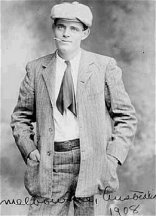
World Traveller |
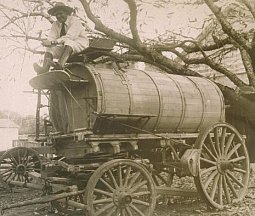
Jack On Water Wagon |
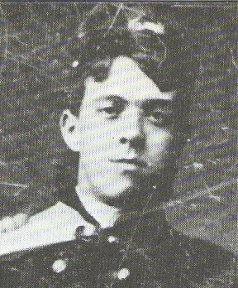
Cadet Ed Burroughs |
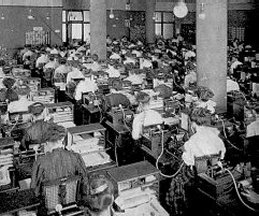
ERB's Dept. at Sears |
ERB was from a privileged family and was sent to good schools. After graduating from Michigan Military Academy went on to a multitude of jobs and locales: MMA instructor, US Cavalry trooper in Arizona, railway policeman, salesman, accountant, Sears Roebuck manager, etc.Both men exhibited a real wanderlust and thirst for adventure -- London in the world of the working man and ERB primarily in the military world and the wild west. London, raised on the docks, turned to the sea and identified with the working class. ERB, raised in the well-to-do part of Chicago in the mid-West, turned to the wide open spaces of the American West and identified more with the upper classes: officers, people of fame, and imaginary princes, nobles, aristocrats and kings. As young men, they both worked for ice companies: London worked on an ice wagon and ERB worked as a company bill collector. Both were millionaires by age 40.
PERSONAL PHILOSOPHIES
London was a strong spokesman for socialism. His left-wing philosophy is seen in the visionary novel The Iron Heel (1908). John Barleycorn (1913), which describes London's drinking bouts, connects him with such later authors as Charles Bukowski, Jack Kerouac, Ernest Hemingway, John Steinbeck, Jack Kerouac, and Robert Ruark. Upton Sinclair has often been considered London's literary successor.On the other hand, the author's views about the superiority of white people and Social Darwinism placed him among ultra-right conservatives. He became the richest socialist in the country -- the first American author to earn a million dollars from his work. He moved to the political right near the end of his life, and even resigned from the Socialist party, alleging that it was too tame and too passive. He voted Republican in 1916 and supported the Allies in WWI. The plot of The Valley of the Moon (1913) shows a distinct departure from socialism.
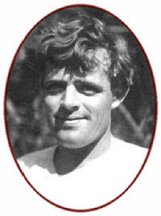
The "Working Man" |
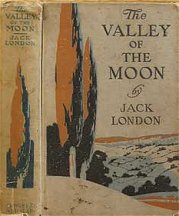
Capitalist's Retreat |
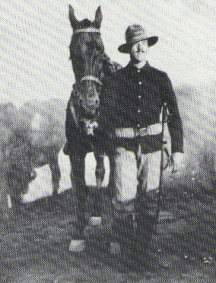
Cavalry Trooper Burroughs |
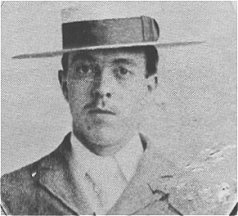
A Dapper Young Ed Burroughs |
ERB was a life-long Republican, taking a strong pro-military stance in most situations. He inherited his father's morality, devotion to the military, and belief in capitalism, which his fertile imagination molded into original science fiction, sword and fantasy, and adventure themes so often imitated by other writers in decades to come.Both exhibited these ideals in their writing, but although they were poles apart politically for most of their careers, they shared a love and respect for nature and environmental issues.
LOOKING FOR GOLD
In 1897, London joined the Klondike gold rush, accompanied and bankrolled by his much older brother-in-law, Captain Shepard. They climbed the Chilkoot Pass and entered the interior in a futile search for the yellow metal.

Chilkoot Pass |
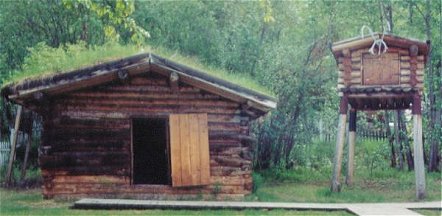
Jack London's Northern cabin today. |
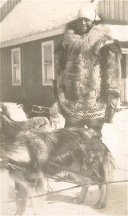
London of the Yukon |
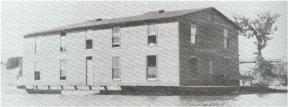
The Burroughs Snake River Houseboat ~ Headquarters of their gold dredging enterprise |
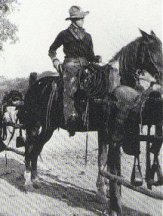
ERB the cowboy |
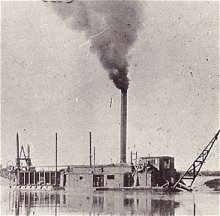
Burroughs-Sweetser gold dredging equipment |
ERB joined his older brothers on their ranch and gold dredging enterprise living in their large houseboat on Idaho's Snake River.Both men were attracted to the frontier through their thirst for adventure and dreams of quick riches.
THE MOTHERLODE
In May 1898 London came down with scurvy and had to leave the Yukon to return to California without having discovered his fortune in gold.

Yukon Prospector |
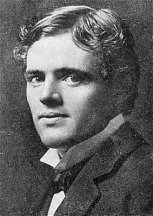
Back in California |
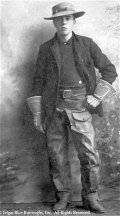
Idaho Cowboy |
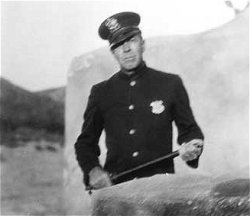
Railroad Policeman in Salt Lake City |
ERB and his brothers, George and Harry, didn't find their fortunes in Idaho. There wasn't enough income to support all the Burroughs families, so his brothers paid his train fare to Utah where Harry had found him a job as a railway policeman in Salt Lake City.Both men had uncovered a Motherlode of experience from which they would draw material for future stories.
POVERTY AND REJECTION
London returned from the Yukon with only $4.50 worth of gold. He could not find steady work. In desperation, he sold many of his belongings and turned seriously to writing. His writing output was prolific, but because of lack of experience and direction it only garnered stacks of rejection slips until he finally sold a story in December 1898 -- a story of the North: "To The Man On Trail." The real turning point was the sale of "An Odyssey of the North to the respected, Atlantic Monthly for a monumental $120. After this there was no looking back.
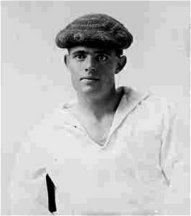
Tough Times |
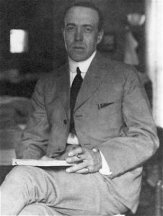
The Lean Years |
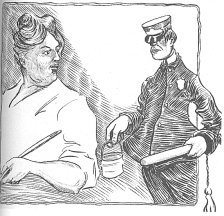
ERB Cartoon: RR Dick |

Doing the Laundry |
ERB became disillusioned with his job as a railway policeman and their poverty situation in Salt Lake City. He and Emma sold their furniture for railway fare back to Chicago. Burroughs then experienced years of many failed business ventures. Prolonged poverty conditions forced them to pawn Emma's jewelry and to live with the Hulbert family for a time. In desperation Ed, the dreamer, wrote a wildly imaginative tale, Under the Moons of Mars, that was immediately accepted by the pulp magazine, Argosy: All-Story Weekly in 1911.Both turned to writing after they had hit rock bottom poverty -- despite having had much formal education in writing skills. London was finally published after receiving hundreds of rejection slips. ERB's first submitted manuscript was accepted by a major pulp magazine.
BOYS' TOYS
London loved to sail. He spent much time on the docks and the sea seemed to be in his blood. In 1891 he borrowed $300 from "Aunt" Jenny Prentiss (a former slave, who had served as baby Johnny's wet nurse) to buy the sloop "Razzle Dazzle" and he became an oyster pirate on San Francisco Bay. He also worked on whaling and sealing ships. After his success as a writer he was able to afford his own sailing craft, "The Snark," on which he made voyages to Pacific islands.
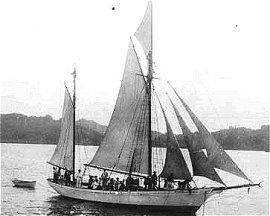
London's "The Snark" |
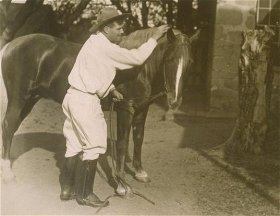
London the Horseman |
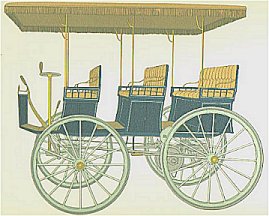
Ed's 1893 Electric Horseless Carriage |
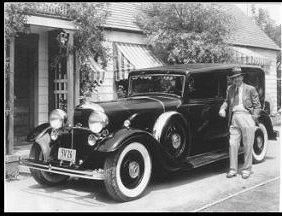
Ed and a model of later vintage |
ERB loved exploring by auto. He had driven the first electric horseless carriage in Chicago at the Columbian Exposition of 1893. Through his lifetime he owned many powerful cars: Packards, Cords, Republic trucks. He sometimes dreamed of having his own boat and enjoyed excursions at sea in boats owned by friends, although he once admitted to becoming bored with the experience, except for when he piloted the crafts himself. He settled for many liner cruises and took long trips on military ships in WWII.Both men were avid horsemen and had a great urge to travel. Many of their true life experiences were more exciting than the fictional adventure they penned.
FIRST WIVES
London married his 23-year-old math tutor and friend, Bess Maddern. It was a Victorian wedding based on “good breeding,” rather than love. He wanted to marry, not for love, but for rational reasons and to prove that love is an illusion and romance a falsehood. Their honeymoon consisted of a bicycle ride to Santa Cruz. He and Bess had two daughters -- Joan and Bess (Becky).
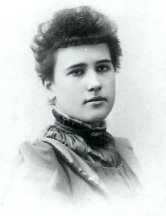
Bess Maddern |
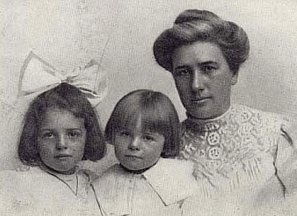
Joan and Bess (Becky) and mother Bess London |
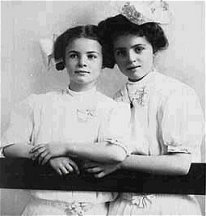
Joan and Becky |
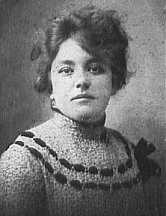
Emma Centennia Hulbert |
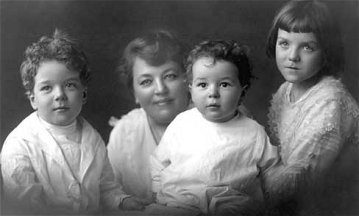
Hulbert, Emma, Jack, Joan Burroughs |
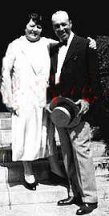
Emma and Ed |
ERB married longtime girl friend Emma Centennia Hulbert, who came from a wealthy Chicago family. She apparently had waited for him for years until she though he had gotten the wanderlust out of his system. They went on to have a daughter, Joan and two sons, Hulbert and John Coleman. She dutifully followed him on many trips through the West.Both men married in 1900, for the first time. Both named their first-born, "Joan" and their second child after the mother. Their wives were excellent sounding boards and proof readers for their early writing. The first wives were strong family raisers, supportive, and of great assistance in their husbands' writing endeavours. They were devastated when dumped and never forgave their ex-husbands -- and were so jealous of the new wives that each forbade her children to have any contact with them.
SECOND WIVES
In 1903, London separated from Bess and married his secretary, Charmian Kittredge -- this time "for love." They played, travelled, wrote and enjoyed life together until London's death. Their only child, Joy, died a few hours after birth in 1910.
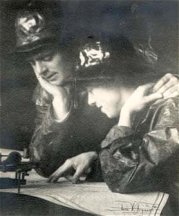
Jack & Charmian planning cruise |
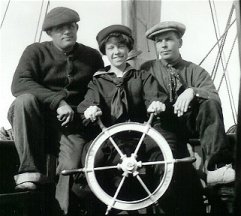
Jack and Charmian at sea |
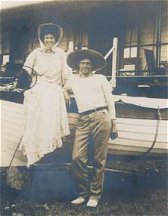
Charmian and Jack |
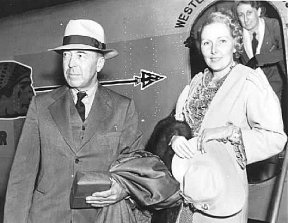
Ed and Florence returning to LA after their Las Vegas wedding |
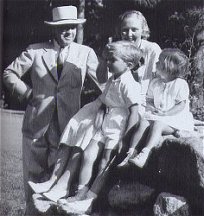
Ed and Florence with her children, Caryl Lee and Lee |

Tennis is Hawaii . |
In 1934, ERB divorced Emma and married a much younger and recently divorced Hollywood starlet, Florence Gilbert. They enjoyed a few years of Hollywood social whirl before moving to Hawaii, along with Florence's two young children. They divorced in 1941.Both second wives were well known to the London and Burroughs families. Bess had often confided in her one-time friend Charmian about Jack's philandering and Florence had been Joan's (ERB's daughter) best friend. The second wives were in some ways more glamorous and adventurous and pulled both authors out of bouts of depression.
THE GAME
London's favourite sport was boxing -- he enjoyed the science of the sport and the fact that it evenly pitted man against man. He boxed regularly on land or sea with friend Jim Whitaker and he never failed to attend an important match as a spectator. The sport is well represented in his book, The Game.ERB was a devotee of physical fitness. ERB's Tarzan creation became the ideal for generations of boys and men. Most of his heroes and heroines were scantily clad and were well portrayed in film by actors and by the many artists who portrayed these characters in illustrations for novels, comics, posters, etc. ..
Both men admired the human form and descriptions of such perfection are found throughout their writing. They were both fans of boxing and wrestling matches. ERB attended live matches well into his 70s and broadcast matches provided some of his most enjoyable TV watching.
BODY OF WORK
Between 1900 and 1916, London completed over 50 books and hundreds of short stories to became the highest paid, most popular novelist and short story writer of his day. Many hailed him as the new Kipling.
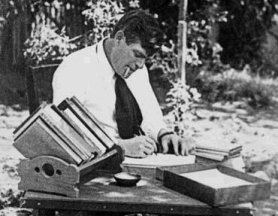
London writing at his outdoor desk at the ranch |
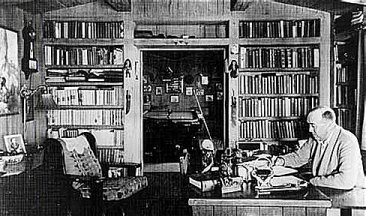
ERB writing in his Malibu study |
In 1914, Burroughs' first book, Tarzan of the Apes, was published and he went on to become one of the world's most popular writers for the next 36 years of his life. . . and beyond. In a productive year he would write up to 400,000 words. He once jokingly commented: "If you write one story, it may be bad; if you write a hundred, you have the odds in your favor."Both authors followed a strict regimen of writing each morning. London forced himself to write 1,000 words daily. The works of both London and ERB have sold in the millions are still in print and popular into the 21st Century. Their stories were their only real income for many years. Burroughs' career was taking off around the time of London's death in 1916.
|
|
|
|
|
|
|
|
|
|
![]()
![]()
![]()
![]()

![]()
BILL
HILLMAN
Visit
our thousands of other sites at:
BILL
AND SUE-ON HILLMAN ECLECTIC STUDIO
ERB
Text, ERB Images and Tarzan® are ©Edgar Rice Burroughs, Inc.-
All Rights Reserved.
All
Original Work ©1996-2005/2018 by Bill Hillman and/or Contributing
Authors/Owners
No
part of this web site may be reproduced without permission from the respective
owners.